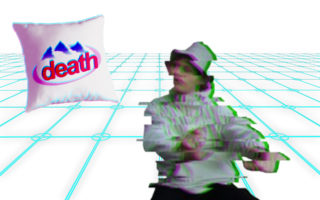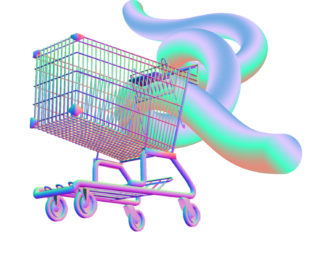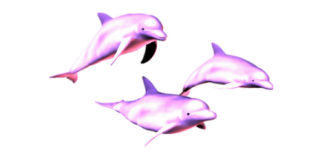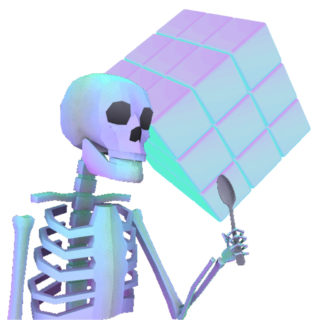All that is solid melts into air: 10 years of vaporwave
The uncanny appeal of one of the defining art forms of the 2010s

The uncanny appeal of one of the defining art forms of the 2010s
Even if you’ve never heard vaporwave before, it’ll sound familiar when you do. Most of its central components are well-known to any Western listener: the sound of adverts, shopping centres, slowed-down pop classics, hold music and turn-of-the-millennium computing. Over the last decade, the amorphous, glassy-eyed aesthetic of vaporwave and its apparently endless family tree of subgenres (hardvapor, vaportrap, mallwave, Simpsonwave, future funk) has embedded itself deep into the subconscious of not only the extremely online, but millions of pop music fans the world over, whether they’re aware of it or not.
Though long derided and frequently declared DOA by its original fans, vaporwave remains, if not alive and well exactly, truculently undead. But what is this strange, shape-shifting microgenre beneath the claims of its inherent hauntology and time-bending power? Ten years on from Daniel Lopatin’s Chuck Person’s Ecco Jams and nine years from James Ferraro’s Far Side Virtual, arguably two of vaporwave’s most significant foundational works, it’s worth investigating how this stuff developed, why it “died”, and what makes it endure as such an important cultural touchstone in 2020.

Let’s start with an often-abused term, these days as readily associated with the rightwing conspiracy theories of Jordan Peterson et alas it is with its actual definition and social meaning: postmodernism. The American theorist Fredric Jameson describes postmodernism as “the cultural logic of late capitalism”, the dominant aesthetic and intellectual expression of the hegemonic economic conditions of the West. Following the scorched-earth future-building of modernism, in very general terms postmodernism is less dogmatically progressive than its predecessor, more given to irony, juxtaposition, kitsch, and nostalgia.
In the conception of Jameson and his fellow travellers, postmodernism emerged from modernism in the latter part of the 20th century as the world sped towards the neoliberal settlement that, ailing though it might be, we’re still grappling with today. Francis Fukuyama’s 1992 proclamation of “the end of history” is its most telling piece of rhetoric. The narrative goes something like this: Nazism defeated, the Soviet Union dissolved, the years of Clinton, Blair and things only getting better beckoning – liberal democracy has won out, and the eternal question of what is to be done has an answer. The “final form of human government”, as Fukuyama puts it, has been achieved, and the political struggles that constitute the raw material of history settled. Modernism, having emerged around the turn of the century amid a blaze of technological progress, radical politics and utopian thinking, was deeply enmeshed with the deviations from liberal capitalism listed above, as the “cultural logic”of those political projects. Now that they were apparently dead and buried, modernism has no more future left to build, and all that remains for culture is an embrace of this formless, time-warped present: the era of postmodernism.
There is far more to postmodernism than these qualities, and doubtless any scholar of the subject is sweating with rage at the messy summary above. But this broad-brush understanding of postmodernism is useful for anyone curious about vaporwave, where it came from, and why it still matters.
Vaporwave is, at base, a nostalgic genre. It’s not alone in this: a great deal of indie and rock, for example, remains stuck in the 1970s and ’80s, endlessly rehashing the great ideas of Ian Curtis, Lou Reed and Patti Smith with diminishing returns. But it’s what vaporwave is nostalgic for that’s so interesting. It’s the sound of people born in the 1980s and ’90s – significantly, shortly before or not long after the fall of the Berlin Wall – reaching back to a version of not just their youth, but their infancy. Like the objects of most nostalgic impulses, these visions of the past can’t be said to have actually existed in any meaningful way, but that doesn’t diminish their rose-tinted appeal.
It’s also, perhaps more than any other music genre, inherently capitalist. That’s not a value judgement, nor a comment on the politics of its creators or fans, but the simple fact of the fabric of the music itself. Almost every sonic element that vaporwave either lifts wholesale or draws heavily upon is commercial to the core; whether it’s call centre hold music or an advert score, this is the sound of transactions, of purchases, of consumption. Vaporwave riffs upon the symbols of capitalist placation and exchange, a sonic analogue of the dopamine hit of a perfect buy.
 I first properly encountered vaporwave around the middle of the 2010s, while I was at university. I’d been vaguely aware of it for a while, but it took a couple of years of living with an extremely online friend for me to immerse myself in it fully. When it clicked, though, I was hooked – Blank Banshee 0 was the soundtrack to my late-night dissertation sessions in the library – and remain so.
I first properly encountered vaporwave around the middle of the 2010s, while I was at university. I’d been vaguely aware of it for a while, but it took a couple of years of living with an extremely online friend for me to immerse myself in it fully. When it clicked, though, I was hooked – Blank Banshee 0 was the soundtrack to my late-night dissertation sessions in the library – and remain so.
I was a few years late to the party, unlike my housemate. Chuck Person’s Ecco Jams and Far Side Virtual were well-established classics by the time I came across them: warped, disjointed things that longed for the familiarity of the recent-ish past while subtly taking the piss out of that nostalgic impulse. Listening to those albums, one feels you’re being let in on a sophisticated joke, without ever being explicitly told the punchline.
“I always hoped [music like this] would be something people would just do – it’s kinda folksy by nature,” Daniel Lopatin said in a 2013 Reddit Ask Me Anything Q&A (an appropriate medium, considering the centrality of forums like Reddit to the genre’s development). His hopes were largely borne out: in the years that followed the release of Ecco Jams, an increasingly populous corner of the internet exploded with vaporwave, and its fast-evolving derivatives. A great deal of the best stuff was by one person: Ramona Andra Xavier, aka (deep breath) Macintosh Plus, Vektroid, New Dreams Ltd, PrismCorp Virtual Enterprises, Laserdisc Visions, dstnt, Sacred Tapestry, 情報デスクVIRTUAL – the list goes on.
Depending on how and what you count, Xavier released twelve or more albums between 2010 and 2013, under almost as many pseudonyms. Perhaps the best-known product of this flurry of invention is her now-iconic 2011 record as Macintosh Plus, Floral Shoppe. You’ve probably seen the cover art referenced in countless memes or lurking in your YouTube recommendations: the mounted head of a classical statue gazes, pupil-less, from its hastily-photoshopped position in the foreground of a pink-and-black chequerboard-floored room. An indeterminate distance behind, a generic cityscape image is “hung” on the “wall” – as if this artist’s impression of an interior has such things – the kind of artwork at which one might gaze idly while waiting for a dental appointment. The artist name and album title, in neon green Japanese text (other than the suffix “MAC”) complete the picture, in its top-right corner.
 It’s the perfect visual accompaniment to the album itself: vaguely familiar, vaguely reminiscent of X or Y, but uncannily dislocated from whatever referents it might bring to mind. Floral Shoppe might be the quintessential vaporwave album: AOR synths and gated drums trundle in and out of earshot like badly-rendered background characters in a video game, the tempo and key constantly bumping up, down and sideways. Its unrelenting shifts echo the restlessness of the millennial and Gen Z attention span, darting here and there as if between browser tabs and group chats, rarely if ever achieving the resolution to which so many of the ’80s and ’90s ballads that Xavier samples are designed to build. It’s disorientating, unsettled, and, like so much vaporwave, weirdly comforting.
It’s the perfect visual accompaniment to the album itself: vaguely familiar, vaguely reminiscent of X or Y, but uncannily dislocated from whatever referents it might bring to mind. Floral Shoppe might be the quintessential vaporwave album: AOR synths and gated drums trundle in and out of earshot like badly-rendered background characters in a video game, the tempo and key constantly bumping up, down and sideways. Its unrelenting shifts echo the restlessness of the millennial and Gen Z attention span, darting here and there as if between browser tabs and group chats, rarely if ever achieving the resolution to which so many of the ’80s and ’90s ballads that Xavier samples are designed to build. It’s disorientating, unsettled, and, like so much vaporwave, weirdly comforting.
Not long after Floral Shoppe, somewhere between 2012 and 2014, the rumours of vaporwave’s death began to circulate. It had escaped its online niche, started being algorithmically recommended to outsider, become endlessly memed. It had reached the internet equivalent of Middle America and England. There was still some widely-acclaimed vaporwave or vape-adjacent music released around this time – the aforementioned Blank Banshee album, for example. But it did undoubtedly become more popular, more mainstream, and as is always the case when a genre explodes, it gave rise to its fair share of rubbish imitations.
Hang on, though. Imitation, and indeed rubbishness – if we’re talking production value and technical accomplishment – are both sort of integral to vaporwave. So are the commercial netherworlds of small-town America, out-of-town retail parks and shopping centres. This is music that is borne of consumption, with simulacrum one of its most-used tools. Wider exposure, greater consumption, cannot kill it.
As such, whatever the purists may say, vaporwave of varying kinds has continued to be made ever since, and its influence is everywhere. Daniel Lopatin himself, better known as Oneohtrix Point Never, may have moved away from straight-up vaporwave into a wider variety of experimental electronic music, not to mention becoming an in-demand Hollywood film score composer, but the time-warped unheimlich of his early work remains identifiable. The intensity of the recent Safdie brothers thriller Uncut Gems, for example, wouldn’t have half its bite were it not for the otherworldly synths of Lopatin’s neon-lit, muzak-gone-maximalist score. Elsewhere, the distinctly vapey nature of early PC Music is self-evident: it situates itself in the same artificially-lit shopping centres and arcades of vaporwave, but doses the latter’s tranquilised atmospherics with poppers, speed and helium to create a hyperactive copy-of-a-copy of turn-of-the-millennium bubblegum pop. Considering the world-bestriding prominence of PC Music affiliates and fellow travellers like Charli xcx, Sophie, 100 gecs, Grimes, and even Caroline Polachek and Carly Rae Jepsen, not to mention the ubiquity of the backlit, day-glo aesthetics that vaporwave significantly helped bring back into fashion (see Stranger Things, Drive, Arca, Kim Petras), and the extremely online, highly referential and consumer-lethargic nature of so much contemporary rap, it’s hard to suppress the notion that a decade on from its advent, we’re still living in vaporwave’s world.

In Esquire’s 2016 history of vaporwave, Scott Beauchamp draws a parallel between the genre and punk rock, reasoning that, “It’s political. Its first priority isn’t making the charts; in fact, its identity is bound up in resisting commercial success, in mocking it. It’s really simple to make.” Yet this is based upon an entirely aesthetic analysis of the politics of punk and its relationship to commercial success, as opposed to a material one.
It’s useful to contrast this with Dave and Stuart Wise’s flawed but provocative 1978 pamphlet The End Of Music, which critiqued punk as the expression of an essentially inter-bourgeois antagonism that recuperated pop culture for capital by giving “aspects of capital an illusory radicalism”. In this reading, by aestheticizing one particular version of “rebellion” without fundamentally challenging the material conditions of the system it purported to be against, punk takes “the barbarity of the commodity at face value”, and stifles the possibility of genuine working-class emancipation. The material conditions of the time, that allowed punk to happen – comparatively low living costs, a liveable dole, enough housing stock to create plenty of space for squats and free spaces for shows and events – were already under threat, and punk didn’t (perhaps couldn’t) do much to change that direction of travel.
This isn’t a simple argument about punk’s co-opting by capital as such, the classic “sellout” line that runs from an authentic original to a commercialised unit-shifter. Wise’s point is by lending the artistic landscape of the existing capitalist system a subversive veneer, punk helped that system evolve aesthetically, remaining more relevant to a new generation and further distracting from its economic underpinning. It was a form of rebellion that capitalism could easily contain and eventually profit from. Looking at what followed – Thatcher, Reagan, financialisation, a chopping-away at the welfare state which had allowed so many artists the kinds of time and space to create that no longer exists in 2020 – it’s a persuasive counterpoint to the hackneyed accounts of the singularly revolutionary punk moment.
If punk built itself upon a stylised, abstracted image of rebellion (“if” being key here), vaporwave channels a similarly stylised and abstracted feeling of consumerist fatigue and acquiescence. But what are the material conditions from which vaporwave arose, and what change, if any, is it arguing for?
Punk emerged as the industrial capitalism of Britain and America was beginning to falter, the postwar settlement that created a relatively stable, wealthy working class being ruptured by conservative economics, conversant union militancy, and shifting geopolitical power. Over three decades later, vaporwave arrives at the other end of that process of deindustrialisation. Service jobs, data entry and the gig economy having largely replaced “traditional” manual and manufacturing-based workplaces, the society from which vaporwave arose was by nature highly individualised, atomised and unstable. When they once might have been working in a factory or dock, many young people had few options beyond the local retail park or fast food chain as they came of age in the early 2010s, looking for work and, in some cases, becoming interested in music. In that context – your personal and professional lives increasingly becoming intertwined, mediated by technology and stripped of agency by an economic system now decades-deep into a project of crushing worker power – vaporwave begins to make a lot of sense. Add to that the existential anxieties of our time – this music may predate coronavirus, but not climate breakdown – and the implied sense of exhaustion and retreat does too.
 As teenager Michael Tills says in a MEL Magazine feature about mallwave, a variant of vaporwave that makes its consumerist nature even more explicit, this music “does let me escape from the shittiness of everyday life. It’s just a couple of hours in a day where everything at least feels okay, that I don’t have to worry about whether or not I’m going to get a job, the political situation in the US – all that shit. I guess it makes me think that there was a better time, or a time when people in this country felt better.”
As teenager Michael Tills says in a MEL Magazine feature about mallwave, a variant of vaporwave that makes its consumerist nature even more explicit, this music “does let me escape from the shittiness of everyday life. It’s just a couple of hours in a day where everything at least feels okay, that I don’t have to worry about whether or not I’m going to get a job, the political situation in the US – all that shit. I guess it makes me think that there was a better time, or a time when people in this country felt better.”
This is why vaporwave remains so significant. Its relationship with the lived conditions of life in the 2010s is complex, but arguably more materialistic than most genres that are similarly dubbed “the sound of x or y”. This is not only the music of alienation, but music as alienation; to clumsily paraphrase Marx, the further away from the means of production a worker becomes, the more alienated they become from their labour – their work is decreasingly their own, as the value it produces belongs to someone else. Now that service and retail are the dominant job providers of the global north (with the ultimate abstraction, finance, underpinning everything), such alienation becomes hegemonic. Vaporwave doesn’t just arise from these conditions, it’s made from them, every warped sample of hold muzak or commercial jingle a fundamental part of the economic system that rules our lives. Its nostalgic tendencies may be based on a version of the past that didn’t exist, but that’s precisely due to the nature of the present that does.
You might notice that much of this is written in the present tense, despite this essay ostensibly focusing on what is now a decade-old genre. That’s primarily because, for all the upheaval of the second half of the 2010s, most of the fundamental material conditions haven’t truly changed. Some have intensified, and some have taken on new connotations, but economic and social life is essentially pretty similar: industry replaced by service, ever-decreasing class organisation, technological atomisation, ecological collapse, widening inequality. The great electoral hopes of the British and American left – perhaps the last purely parliamentary alternatives to a system that’s now locked firmly into a death drive – have been dashed, and in real terms great swathes of the population remain just as alienated and helpless as they were a decade ago, however much liberal pundits may protest about “populism”, “idealism”, or “incivility”. The last few years may have seen hairline cracks emerge in the edifice of the post-1991 consensus of free-market economics, liberal statecraft and hawkish foreign policy (what Mark Fisher described as capitalist realism) but its predicted – and necessary – collapse has failed to materialise.
Vaporwave is as pure a musical reflection of the material and aesthetic conditions of our time as you’re likely to find. As wonderful as so much vaporwave might sound to its fans – this writer included – its continued relevance is deeply troubling.
James Ferraro – Far Side Virtual
Vaporwave at its sprightliest and most surreally optimistic, The Wire made this their album of the year in 2011.
Daniel Lopatin – Chuck Person’s Ecco Jams
Arguably the record that kick-started vaporwave, from the artist also known as Oneohtrix Point Never: woozy, warped, utterly addictive.
Macintosh Plus – Floral Shoppe
The iconic document of Peak Vaporwave, and the ultimate example of the a e s t h e t I c you’ve seen in endless memes.
Blank Banshee – Blank Banshee 0
Of all the artists who took the original sound of vaporwave and pushed it into fascinating new directions, Blank Banshee may have been the most accomplished, and his debut remains his most exciting piece of work.
Vektroid – Neo Cali
Another release from the artist also known as Macintosh Plus, this is vaporwave at its most serene and dreamlike.